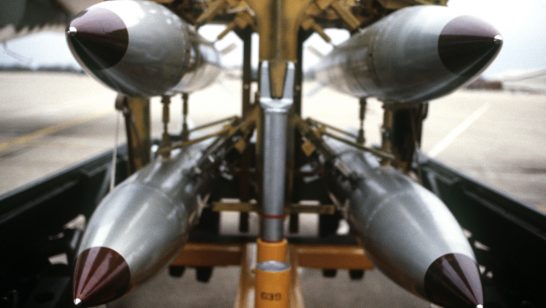
The disappointing outcome of the 2015 Non Proliferation Treaty (NPT) Review Conference will deprive the nuclear non-proliferation regime of updated benchmarks for the next five years. This weakens the ability of the states which are party to the treaty to multilaterally address the key issues within the NPT’s three pillars: non-proliferation, disarmament and peaceful uses of nuclear energy. It may also open the way to alternative and not necessarily genuine multilateral approaches. The lack of a final NPT consensus text will also affect the way in which we deal with the enrichment of uranium and the separation of weapons grade plutonium; issues which have haunted the international community since the early days of the nuclear era and which lie at the heart of the Iranian nuclear problem today.
The Legacy of Reprocessing and Enriching
The first attempt to multilaterally address enrichment and reprocessing issues goes back to the Baruch plan of 1945, a U.S. initiative aiming at placing the whole field of atomic energy, including “all phases of the development and use of nuclear energy”, under the control of an international body. Despite the early establishment of the IAEA, this project never saw the light of day. No meaningful progress was made, even with the entry into force of the NPT in 1970. The principle of the “inalienable right… to develop research, production and use of nuclear energy for peaceful purposes” has been interpreted as including a “right” to produce the fuel necessary to feed nuclear power plants. But this interpretation was not expressly included in the language of the Treaty. To this day this issue remains unclear, ambiguous and controversial.
A limited number of countries possess the capacity to reprocess and enrich. The five NPT nuclear weapons states (NWS) were the first to acquire this technology and non-NPT, nuclear armed countries (India, Pakistan, Israel) followed suit. Even non-nuclear weapon states such as Germany and the Netherlands joined the UK in the URENCO enrichment consortium. Italy and Iran (during the time of the Shah) became the financial partners in the French EURODIF enrichment project. Japan encountered no major obstacles in carrying out its ambitious reprocessing program and Argentina joined Brazil in mutually verifying their respective fuel producing activities.
One of the main tasks of the Zangger Committee, established by a small group of NPT partners, was to prevent the proliferation of this costly and controversial activity. Further efforts were aimed at convincing countries that they would be better off receiving assurances from nuclear fuel suppliers rather than embarking into enriching and reprocessing. From 1977 to 1979 the issue of strengthening of assurances of nuclear supplies while minimizing the proliferation risk was at the center of the International Fuel Cycle Evaluation (INFCE) process. In 2004, the Nuclear Suppliers Group (NSG) established specific conditions which a recipient state must meet to be eligible for enrichment and reprocessing (ENR). That same year the Bush administration tried to introduce a “golden rule” arrangement providing that only countries already possessing enrichment and reprocessing technology would be entitled to this technology. This issue was also addressed bilaterally: in its 1972 agreement with the U.S., South Korea agreed to renounce enriching and reprocessing in exchange for nuclear supply assurances. More recently, the United Arab Emirates accepted the U.S. 2004 “golden rule” in a bilateral agreement, while South Korea and the U.S. have renegotiated their 1972 agreement. The new text is not yet public, though it appears that Seoul, which has become a major nuclear energy producer, will receive more leeway for reprocessing spent fuel and enriching uranium.
The Iran Deal Provisions: A Model for the International Community?
The lack of a consensual final text at the recent NPT Conference weakens the prospect of multilaterally addressing the enrichment/reprocessing issue. However this does mean that the negotiation between the E3+3 and Iran acquires even greater relevance. According to the Joint Statement by EU High Representative Federica Mogherini and Iranian Foreign Minister Javad Zarif, the key parameters of a Joint Comprehensive Plan of Action (JCPOA) provide that Iran would be allowed to pursue a peaceful nuclear programme but its enrichment capacity, enrichment level and stockpile will be limited for specified durations and will take place in only one enrichment facility. The other enrichment site will be converted into a nuclear, physics and technology centre with no fissile material. The existing Iranian heavy water research reactor will not produce weapons grade plutonium. There will be no reprocessing and the spent fuel will be exported. A set of measures have been agreed upon to monitor these provisional applications. The International Atomic Energy Agency will be permitted the use of modern technologies and will have enhanced access through agreed procedures, including clarifying past and present issues. More details on the deal are contained in statements made by U.S. and Iranian spokespersons subsequent to the conclusion of negotiations in Lausanne.
All of these parameters, particularly those which are not “Iran specific” and not related to the implementation and removal of sanctions, can become a very useful basis for more general guidelines. It is indeed advisable and even necessary that there should be a link between the number and quality of centrifuges operated by a country and its effective needs in terms of fuel for power-plant and research activities. The stockpiles of nuclear fuel stored should be constantly kept at a minimal level and be utilized as soon as possible. Separation of plutonium should, as a rule, be always strongly discouraged and the spent fuel, as in the case of Iran, should be returned to the original supplier or be exported. Because these provisions are not imposed but would be consensually accepted by a major player in the Middle East such as Iran, who presently chairs the Non Aligned Movement, they could become a model to be adopted by the international community. Some countries from the Gulf region have already indicated their expectation to receive from the U.S. the same treatment granted to Iran.
In sum, a successful arrangement with Iran would not only conclude a dispute which has been going on for over a decade, it could contribute to the establishment of a general rule regarding enrichment and reprocessing as well as boost the project of a WMD free zone in the Middle East which still remains an important NPT objective.
The opinions articulated above represent the views of the author(s), and do not necessarily reflect the position of the European Leadership Network or any of its members. The ELN’s aim is to encourage debates that will help develop Europe’s capacity to address the pressing foreign, defence, and security challenges of our time.


